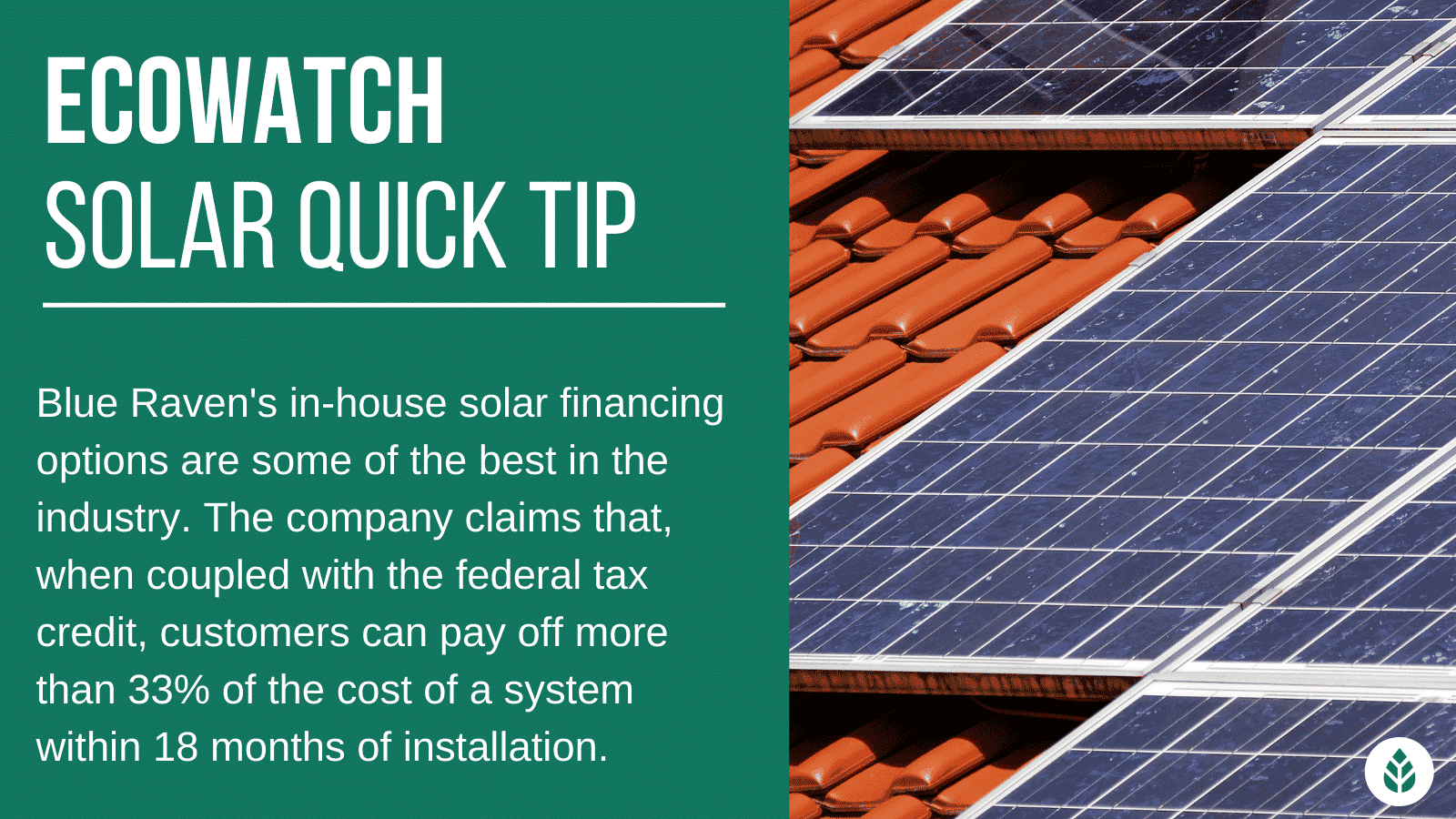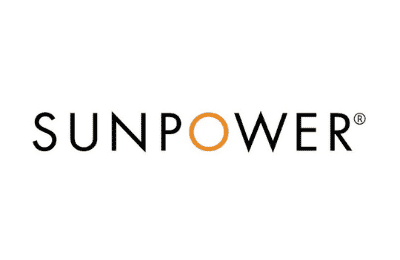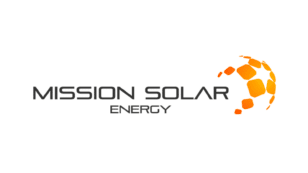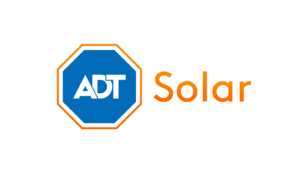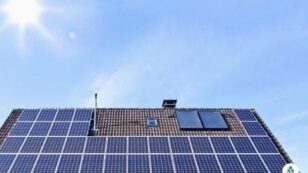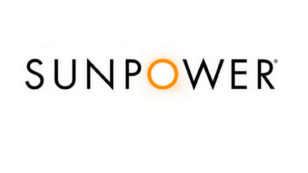
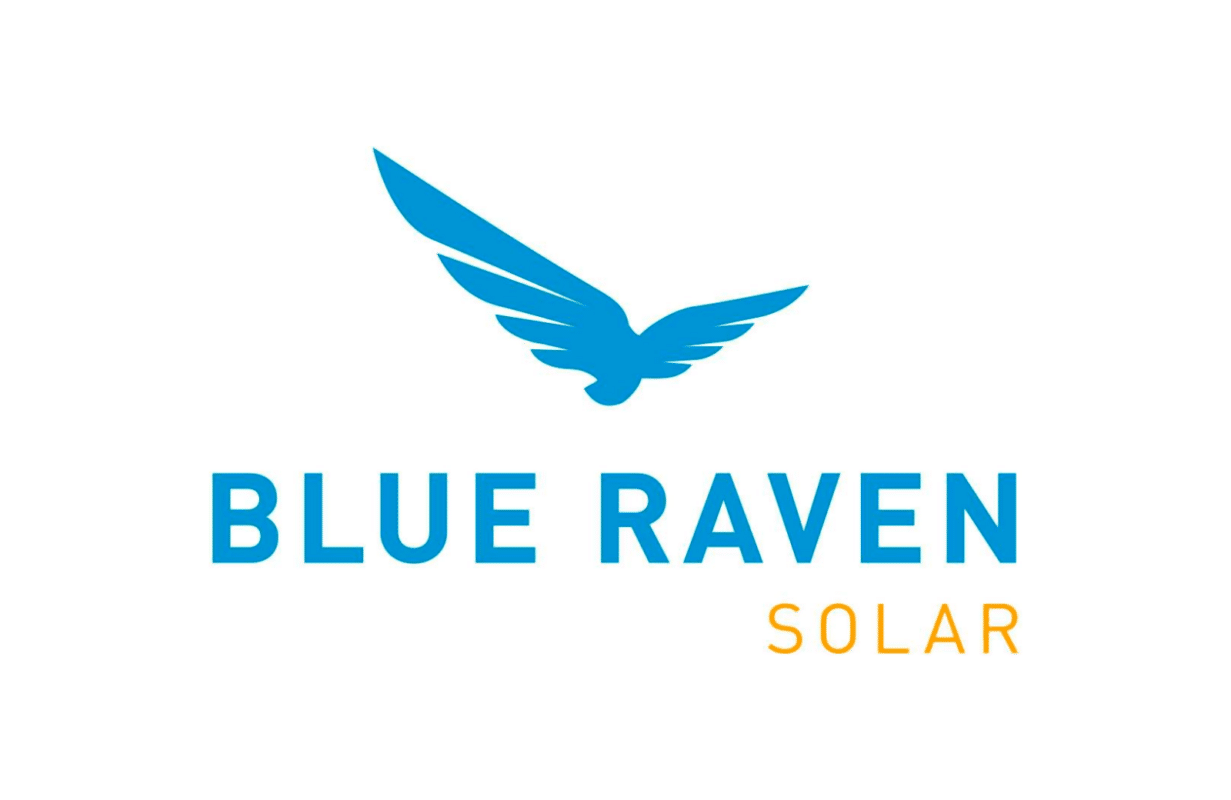
Blue Raven Solar Review (2024 Costs, Panels & More)
In this review on Blue Raven Solar, you’ll learn:
- Can BluePower Plus+ really help you avoid costs for the first 18 months?
- Blue Raven doesn’t offer much customization – will that be a problem?
- What’s changed since Blue Raven was acquired by SunPower?
Continue reading to join millions of other homeowners in finding the perfect solar provider to help you start saving on bills!
Each product and or company featured here has been independently selected by the writer. You can learn more about our review methodology here. If you make a purchase using the links included, we may earn commission.
Blue Raven Solar is one of the largest panel installation companies in the country, with an impressive 200,000+ installations under its belt. The company is best known for its affordability and revolutionary financing options. Combined with the widespread availability across 21 states, countless U.S. residents looking for solar panel installation services are likely to consider Blue Raven.
In this article, we’ll be providing an in-depth Blue Raven Solar review from top to bottom, including a look at the company’s prices, products, panel quality, customer service and more. We’ll also provide some tips on how to save money when going solar with Blue Raven.
Our Take on Blue Raven Solar
Blue Raven Solar is a trustworthy solar installation company with a good track record for customer service, low prices and, perhaps most importantly, innovative financing solutions that make solar equipment more accessible than ever before.
We typically refer to Blue Raven as the best option for affordable and accessible panels, as the BluePower Plus+ financing option keeps upfront costs down and reduces the interest you pay over time for your system.
If you’re concerned about the high cost of converting to solar power, we strongly recommend considering Blue Raven.

Blue Raven Solar
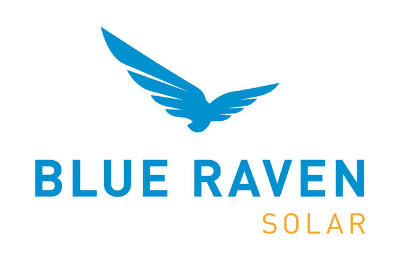
Regional Service
Average cost
Pros
- Industry-leading in-house financing
- Competitive pricing
- Excellent reputation
Cons
- Doesn't offer solar batteries (coming 2022)
What We Like About Blue Raven Solar
We think the most notable things about Blue Raven are the company’s low prices and super-accessible financing options.
With the BluePower Plus+ program, you can finance your system to get all of the benefits you’d miss out on with a lease, but you also don’t pay interest for 18 months and still get a fixed interest rate to keep long-term costs down. With solar array prices averaging around $29,970 before the federal tax credit, solar could very well be out of the question without an option like Blue Raven’s financing program.
The company was also acquired by SunPower in 2021. SunPower is a leading panel manufacturer — through its sister company, Maxeon — and installer with an industry-leading warranty package, so Blue Raven is now backed by one of the most trusted solar companies in the country. Not only do you get an affordable system, but you get one that comes with minimal headaches after installation, thanks to the robust coverage.
What We Don’t Like About Blue Raven Solar
There are a few negative things about Blue Raven Solar to be aware of before committing to service from the provider.
First off, there are minimal customization options available for your solar array. That means that you won’t have a lot of equipment options to add to your panels, so the functionality of your system could be limited.
For example, the company only offers SunVault batteries from SunPower and not some of the more high-demand batteries, like Tesla Powerwalls. The company also doesn’t offer electric vehicle (EV) chargers or other add-on products, so it’s only a good option if you’re just looking for the basics.
Additionally, since Blue Raven’s operations still remain separate from SunPower’s for the time being, you won’t have access to solar leases or power purchase agreements (PPAs) from Blue Raven. We don’t recommend these options anyway, and the financing availability from the company is far more appealing, but if you don’t qualify for the BluePower Plus+ program, then you may not be able to go solar with Blue Raven at all.
Blue Raven Solar Panels
Blue Raven installs panels manufactured by a handful of companies, including SolarEdge, Solar World, Hyundai, Axitec, Canadian Solar, and Trina. Of these brands, it appears that Canadian Solar and Trina are two of the most popular options available from Blue Raven.
Canadian Solar panels have an efficiency rating that averages around 20%. For comparison, Maxeon panels from SunPower top out at around 22.8%, which is the highest in the industry for residential photovoltaic (PV) panels.
The 20% efficiency boasted by Canadian Solar panels should be plenty for most homeowners to offset their utility bills with a rooftop solar array, but you may need an additional panel as compared to the higher efficiency options.
The PV panels from Trina have a slightly lower average efficiency of around 18%, so they’ll generate less electricity per panel. That means you may need a larger roof to accommodate an appropriately-sized system to offset the electricity you would otherwise pull from your utility company.
The upside to both of these options is that they’re significantly cheaper than panels from Maxeon and other high-end brands, like Panasonic and even Tesla. The table below includes a quick look at the most popular Canadian Solar and Trina panels as compared to some other options from Blue Raven. We’ll also include the industry averages so that you can see how this installer compares overall.
| Panel Type | Estimated Cost per Watt (installed) | Cost per Panel (installed) | Power Output | Efficiency Rating | |
| Canadian Solar | Monocrystalline and polycrystalline | $3.67 | $1,247.80–$2,128.60 | 340W to 580W | 15.88% to 20.6% |
| Trina | Monocrystalline and polycrystalline | $3.55 | $1,100.50–$1,420 | 310W to 400W | 16.2% to 20.4% |
| SolarEdge | Monocrystalline panels only | $3.70 | $1,313.50–$1,998 | 355W to 540W | 19.0% to 21.25% |
| Solar World | Monocrystalline and polycrystalline | $3.65 | $912.50–$1,259.25 | 250W to 345W | 14.61% to 17.54% |
| Hyundai | Monocrystalline panels only | $3.47 | $954.25–$1,405.35 | 275W to 405W | 16.6% to 19.14% |
| Axitec | Monocrystalline and polycrystalline | $3.27 | $1,144.50–$1,814.85 | 350W to 555W | 20.13% to 21.51% |
| Industry Average | Monocrystalline and polycrystalline | $3.33 | $999–$1,498.50 | 300W to 450W | 15% to 20% |
Does Blue Raven Offer Any Other Solar Products?
Blue Raven has a decent selection of panels available, but the number of add-on products offered is really where the company falls short. It doesn’t carry any EV chargers, and it only provides one type of solar battery.
SunPower SunVault Battery Storage System
As far as batteries go, Blue Raven only offers the SunPower SunVault, which has a 13 kWh capacity and costs around $14,000 per battery, on average. This is in line with other leading products, like the Tesla Powerwall+, but we’d love to see more options available from Blue Raven.
With that being said, the SunVault system is a good way to add backup power to your home. You can maintain electricity during blackouts using the batteries, and with an islanding inverter — which is standard from Blue Raven — your panels can recharge your batteries during the day if there’s excess production, even while your system is off-grid.
The Enphase App for Solar Monitoring
Since Blue Raven uses almost exclusively inverters from Enphase, you’ll get access to the Enphase mobile app for easy solar monitoring. This app gives you real-time information on home energy consumption, battery life, solar production and more right at your fingertips.
How Much Does Blue Raven Cost?
The cost of a solar system from Blue Raven can vary quite a lot depending on multiple factors, like your location, the panels you have installed, any add-on products you choose, the size of your system and more. It’s challenging to say with certainty what a system from this provider will cost you.
With that being said, customers report below-average pricing compared to estimates from other installers for similarly sized solar arrays. Given the average price per watt of $3.33 in the U.S. and the typical system size throughout the country — 9 kilowatts — the average all-in price for a solar installation is around $29,970 before any tax benefits or other solar perks. This includes a 100% to 200% markup for installation services and a typical cost per watt for equipment only sitting under $1.
Since Blue Raven reportedly has below-average pricing, you can expect your total to come in between $24,000 and $28,000 for a 9 kW system.
Blue Raven Solar Financing Options
As mentioned earlier, Blue Raven revolutionized the solar financing industry with its BluePower Plus+ program. It also has the SmartStart financing program, which is similar to a lease in the payment structure but also leads to panel ownership. We’ll discuss how each of these options works below.
BluePower Plus+ Program
The BluePower Plus+ program most notably offers 18 months of 0-APR financing, which means you enjoy savings from your panels immediately. After that point, you make payments on your solar loan as normal, with the benefit of a year and a half of solar energy savings to help you continue making payments.
This option leads to panel ownership, which means you can still take the federal investment tax credit (ITC) — an average value of $8,991 you’d miss out on if you leased or entered into a PPA. This program also helps you maximize your long-term savings since you’ll see a panel payback period, after which your savings will skyrocket.
We would recommend the BluePower Plus+ financing program over the SmartStart option mentioned below, primarily because you’ll see greater long-term savings from your panels, on average, thanks to no payments for 18 months.
SmartStart Financing Program
The SmartStart program from Blue Raven includes a nominal monthly payment for your system, and then the company will send you a check for excess power, which will continue to keep your monthly payment at that introductory rate for a total of five years. After that, you’ll have a standard financing agreement but with five years of savings to help offset financing costs.
The SmartStart program also leads to panel ownership, so you can still take the ITC and enjoy greater savings over time than you would with a lease or PPA.
How Can You Save Money with Blue Raven?
Blue Raven offers great prices for its equipment and services, but even below-average pricing for a solar array can be prohibitively expensive for many homeowners. Luckily, there are a few ways you can save money when going solar with Blue Raven, which we’ll discuss below.
- Solar batteries
- The BluePower Plus+ program
- More affordable solar panel brands
- Solar incentives
Consider Solar Batteries
First off, you could stand to save money by choosing to install a SunVault system with Blue Raven. Adding solar storage to your array will, of course, increase your upfront price. However, if you live in a state that doesn’t offer net metering, a battery could end up saving you money in the long run.
Net metering is a policy through which your utility provider credits your account for excess power your panels generate and send to the grid. If you don’t have access to net metering, then any additional electricity your panels produce will be lost, and you’ll have to pay the standard energy prices if your array ever fails to keep up with consumption, like at night or on cloudy days.
With a battery, you can bank solar energy to continue to offset electricity consumption even when the sun isn’t shining. This is a particularly good option in areas with high per-kilowatt-hour (kWh) prices and no active net energy metering policy.
Adding solar batteries to your system requires minimal work on your part but could save thousands of dollars on electricity costs over the life of your equipment.
Take Advantage of the BluePower Plus+ Program
Second, you can save money on your system by financing it with the BluePower Plus+ program. This gives you a year and a half to save on your energy bills before any payments are due. If you put those savings aside and then apply them to the principle after the first 18 months, you’ll end up paying less in interest for your system.
Signing up for the program is super simple, and the savings can be on the order of hundreds of dollars over more traditional financing options.
Opt for More Affordable Panel Brands
Blue Raven installs a handful of different panel brands, with the most popular options being from Canadian Solar and Trina. When Blue Raven sends a representative out to assess your home for solar viability, you can discuss the options available with them and ask for a free quote including a more affordable panel brand.
In some cases, this could lead to an overall lower system price, potentially saving you hundreds or even thousands of dollars, depending on the size of your system and some other factors. Plus, all it takes is a simple request to your sales rep.
Take Advantage of Incentives
Finally, you can take advantage of the solar incentives available to you. One of the most important perks to take is the federal credit, which currently provides a credit to your income tax burden for 30% of your entire system cost. Given the average installation costs in the U.S., that’s an average potential savings of close to $9,000. Other perks could lead to savings of over $10,000.
There might be additional benefits available in your state as well, including solar rebates, state credits and more. We recommend asking your sales rep at Blue Raven what perks are available to you. The company is known to provide excellent customer service and should be able to assist you in finding other savings opportunities.
Blue Raven Installation Process
The process of installing solar with Blue Raven is straightforward and shouldn’t require much effort on your part. Overall, the installer is known for fast response times and outstanding customer service, so you can expect few delays and an overall positive experience, especially as compared to other installation companies.
The company states on its website that most installations are completed in just a day, although the total process, which includes pulling permits and designing your system, will take longer than that. We’ll include a breakdown of the process below.
Step 1: Property Assessment
Your first step in getting a system installed is to have a Blue Raven representative inspect your home, take roof measurements and make a property assessment. The rep will look at your home size, a recent energy bill to see average consumption, tree coverage, local weather conditions and more to determine the best system components and system size for your property.
Step 2: System Design and Project Approval
After the assessment, you’ll receive a formal solar proposal to sign. This includes all of the information you’ll need about your system, including the size, the position of the panels and any other equipment, your estimated production rate, expected savings and more.
Step 3: Solar Permits and Ordering Components
Next, the design team at Blue Raven will pull permits for the solar equipment. The approval process can be quite long, so this step alone could take several weeks, depending on how backed up your local building department is. After permits are approved, your components will be ordered, if necessary.
Blue Raven is well-known in the industry for maintaining excellent customer service and communication, despite its large size, and much of its business comes from referrals, which is telling. Throughout the wait, you’ll very likely hear from team members on updates and milestones, as well as an expected installation date and time.
Step 4: Installation
Finally, the Blue Raven installation team will arrive on your scheduled installation day and begin the actual installation. This involves installing the racking system on your roof, attaching the panels, wiring everything, mounting your inverters and connecting your system to your electric panel.
You should plan on being home for the entirety of the installation process. Thankfully, Blue Raven typically completes the installation in just one day.
Watch Below: Are you skeptical of Blue Raven being able to install a solar system in a single day? This quick time lapse video shows how its done!
Step 5: System Activation and Interconnection
After any necessary inspections from electricians and your utility provider, your system can be turned on to start producing power for your home. At this point, you’ll officially be connected to the grid and can begin earning net energy metering credits if they’re available.
Step 6: Solar Monitoring and Incentives
Lastly, your Ble Raven technician should help you set up the Enphase app to monitor your system. If you have any questions about how to use the app, the company’s techs are usually ready and willing to answer them.
The administrative team will then file for any credits or other benefits available in your area. You can, again, ask questions about what’s available, and the company’s reps are usually willing to help.
Blue Raven Solar Warranty
Blue Raven provides a 25-year manufacturer’s warranty for all of the panels it installs, which is standard in the industry. The company also comes in around average in terms of a workmanship warranty, which lasts for ten years.
The 25-year warranty for the equipment should keep you protected from system malfunctions and damages for much longer than they’ll take to pay for themselves. The average panel payback period in the U.S. is 11 years, which means you should have 14 additional years to accrue solar energy savings after your panels pay themselves off. Plus, many panels last for much longer than 25 years, so your savings could be even greater.
While these coverages are standard, Blue Raven goes above and beyond by providing a customer satisfaction guarantee, which takes the place of a production guarantee. The company promises to cover any difference between expected production and real-world production rates, which provides the peace of mind most people look for when making a ~$30,000 investment in their homes.
Where Is Blue Raven Solar Available?
Blue Raven is a national company that services an impressive 21 states. You should be aware that the company could very well expand to additional states in the near future, especially if SunPower — the nationwide company that serves all 50 states and purchased Blue Raven in 2021 — adds coverage. We’ll list the current states Blue Raven serves below.
- Arkansas
- Colorado
- Florida
- Georgia
- Idaho
- Illinois
- Indiana
- Kansas
- Kentucky
- Michigan
- Minnesota
- Missouri
- Nevada
- North Carolina
- Ohio
- Oregon
- South Carolina
- Texas
- Utah
- Virginia
- Washington
Blue Raven Solar Customer Reviews
Overall, the customer reviews for Blue Raven are overwhelmingly positive. Despite being such a large company, it’s clear from reviews and customer reports that there’s still a major emphasis on customer service and communication. Compared to other providers of this size, Blue Raven’s reviews are more often positive.
We’ll explain what we noticed after reading dozens of positive and negative reviews for this provider below.
Positive Reviews of Blue Raven Solar
Most of the reviews for Blue Raven Solar that are positive rave about the company’s communication, which is very often a sticking point for other companies and especially those that are as large as Blue Raven. Customers note that the sales representatives are helpful, the design team is communicative throughout the process, and the installation crew is respectful and courteous.
There are lots of other positive reviews that mention how affordable Blue Raven is and how accessible its products are, thanks to its payment options. Customers also often express in online reviews how effective their solar energy systems are and how quickly they saw a significant dip in their monthly electric bills.
Compared to reviews of other companies, Blue Raven has managed to avoid negative reviews about nationwide companies getting contracts signed and then all but disappearing. It’s clear that Blue Raven’s local teams work hard to uphold a better reputation than many other providers.
Negative Reviews of Blue Raven
There are a handful of negative reviews for Blue Raven that mention things like a lack of communication. Thankfully, these seem to be one-off complaints, and they don’t appear to be indicative of the kind of service you should expect from the company.
The most common thing mentioned in negative reviews for Blue Raven is the aggressiveness of the sales team. The sales reps use door-to-door sales, which many homeowners understandably take issue with. Additionally, the reps are known to be aggressive with phone calls to follow up on leads, which some people say borders on harassment.
Finally, there have been several instances of customers noting that the sales representatives mislead customers, specifically regarding the federal credit. Some people note that the 30% tax credit is framed as a “rebate” that is guaranteed. We strongly recommend you understand how the federal solar credit works before signing any solar agreements with any company.
Overall, the negative reviews for Blue Raven more often call into question the company’s marketing tactics rather than the high-quality service. While getting any negative reviews certainly isn’t a good thing, we’d prefer to see these complaints over a lack of communication or a lack of willingness to honor warranty coverage, which other companies have been guilty of.
Blue Raven vs Other Solar Providers
Blue Raven is an outstanding company to choose if you’re looking for an affordable and accessible solar array and don’t want much in the way of add-ons. The installer mostly handles panels and inverters, and although it offers SunVault battery systems, it lacks the storage options and other add-ons — like EV chargers — that other companies provide.
We’d recommend Blue Raven if you know you just want a simple PV system and are concerned about the average costs of systems in your area. Blue Raven makes going solar cheaper and more accessible than most other companies.
The table below includes a quick comparison of Blue Raven and some other leaders in the solar industry to help you decide if this is the right provider for you.
| Blue Raven Solar (BRS) | SunPower | Tesla | Momentum | SunRun | |
| Year Founded | 2014 | 1985 | 2003 | 2009 | 2007 |
| Areas Served | 21 states | 50 states | 50 states | 11 states | 20 states, plus Puerto Rico and Washington, D.C. |
| BBB Rating | A+ | A+ | N/A | A+ | N/A |
| Services Offered | Solar panel and battery installations; solar monitoring | Solar panel, battery and EV charger installations; solar monitoring | Solar panel, battery, EV charger and solar roofing installations; solar monitoring | Solar panel and battery installations | Solar panel, battery and EV charger installations; solar monitoring |
| Payment Options | Cash and solar loans | Cash, solar loans, leases and PPAs | Cash, solar loans, leases and PPAs | Cash, solar loans, leases and PPAs | Cash, solar loans, leases and PPAs |
| Average Price ($-$$$$$) | $$ | $$$$ | $$$ | $$$ | $$$ |
| Overall Star Rating (Click for our review) | 4.5/5 | 5/5 | 4.5/5 | 4.5/5 | 4/5 |
Overall, we recommend SunPower over these other providers. Although SunPower’s services are more expensive, they provide excellent customer service, panels with a higher efficiency, more payment options, and a full range of solar technology products for system customization.
Bottom Line: Will Blue Raven Work for You?
If you’re looking for a simple solar array and know you don’t want add-on products, then we believe Blue Raven is a great option. The company maintains below-average pricing and a massive service area without sacrificing quality and customer service.
It also makes going solar more accessible overall with its industry-leading financing options. If you think a lease or PPA are the only options that will work for you, we strongly recommend looking into Blue Raven. Its financing provides you with similar savings, but you’ll own your panels, which means you can take the federal credit and enjoy greater long-term savings.
In any case, we suggest you get estimates from a few different providers to compare and find the best value for your money. You can enter your zip code below to get free solar quotes from both Blue Raven and its leading competitors.
Methodology: How We Reviewed Blue Raven
Whenever the EcoWatch team reviews a solar provider, we take a deep dive into the products and services offered, we read through dozens and sometimes hundreds of customer reviews and we rank the company based on a number of criteria.
We’ll discuss some of the more important factors we look at below:
- Reputation (20%): First and foremost, a company’s reputation in the industry and on sites like Better Business Bureau (BBB), TrustPilot and Google Reviews gives us some insight into the quality of products and services provided by an installer. Blue Raven is well-known in the industry to be a reliable and trustworthy solar company that provides excellent customer service.
- Cost and financing (20%) : The relative cost of a company and the payment options offered can have a major impact on its availability and its overall effect on the renewable energy industry. Blue Raven maintains below-average prices and offers some of the best financing programs in the industry.
- Services (20%): Companies that provide a more robust set of solar services are likely to appeal to a wider customer base. Blue Raven falls a bit short here in that it only installs panels and one type of solar battery.
- Installation process (20%): The rating for the actual installation helps us promote companies that make things easy and effortless for customers. Blue Raven gets most installations done in a single day to reduce wait times, and the in-house installation teams are courteous and respectful.
- Customer experience (10%): Your overall experience is crucial when dealing with a solar installer, and things like a lack of communication, poor response times to warranty claims and other issues make a company less desirable overall. Blue Raven provides an outstanding customer experience and is known to remain communicative throughout the entire princess.
- Availability (10%): Finally, companies that are available in more states will naturally appeal to more customers, so we factor the service area into our rating. Blue Raven serves 21 states, which is more than most companies but not as appealing as SunPower or Tesla, which serve all 50.
The cost information presented in this article is derived from a comprehensive analysis, incorporating data from multiple industry sources. The average cost per watt per state was calculated based on figures from Consumer Affairs, Energy Sage, and Berkeley Lab’s Electricity Markets & Policy Department. Additionally, monthly energy consumption and the average monthly cost of electricity were sourced from the U.S. Energy Information Administration, ensuring a well-rounded and accurate representation of the information presented.
FAQs: Blue Raven Solar review
Here are the most common questions we get about Blue Raven Solar. If you have specific questions that aren’t answered here, reach out to our team of solar experts at solar@ecowatch.com.
Yes, absolutely! Blue Raven Solar is a respected and well-known company in the solar industry. Since it was founded in 2014, the company has grown to cover a massive service area spanning 21 states, but it still maintains a reputation for excellent customer service and quality. The company’s ratings and online reviews are very good, especially compared to other solar providers of a similar size. It also has an A+ rating with the BBB.
Yes, SunPower purchased Blue Raven Solar in 2021. The operations within Blue Raven haven’t changed much since then, and it’s unclear if they will moving forward. The provider still offers great customer service and a somewhat limited range of products, which still don’t include SunPower/Maxeon panels.
However, the acquisition did leave Blue Raven with the capacity to install solar batteries — the SunPower SunVault system — which the company had been working on for years prior to the purchase.
The cost of a solar panel system from Blue Raven averages around $22,000 to $28,000, but this number can vary quite a lot based on many factors. The size of your system is one of the largest drivers of price, and you’ll also need to consider the brand of panels you have installed, your location, and more. We recommend getting a free quote at BlueRavenSolar.com to see what your system will total.
Blue Raven Solar’s headquarters are located in Orem, Utah. The company has locations in 20 additional states, including Arkansas, Colorado, Florida, Georgia, Idaho, Illinois, Indiana, Kansas, Kentucky, Michigan, Minnesota, Missouri, Nevada, North Carolina, Ohio, Oregon, South Carolina, Texas, Virginia and Washington.

 233k
233k  41k
41k  Subscribe
Subscribe 

